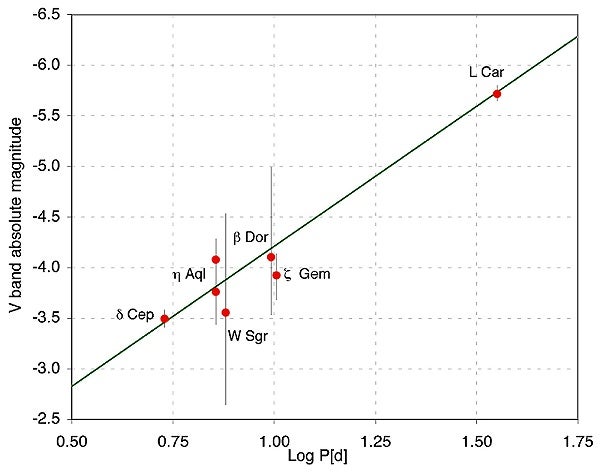Astronomers used infrared observations made with four telescopes in the Very Large Telescope Interferometer system to measure changes in the diameters of seven southern stars directly. A team of French and Swiss astronomers led by Pierre Kervella of the Paris Observatory studied a special class of stars known as Cepheid variables — stars that change periodically in both size and brightness.
The team then combined the data with spectroscopic measurements that showed the speeds of the stars’ outer envelopes as they expanded and contracted. The result was an accurate distance to the stars and a calibration of an astronomical distance indicator called the period-luminosity relationship.
One of the great challenges to modern astronomers is the accurate measurement of the distances to objects, especially those outside our Milky Way Galaxy. For nearby objects like the Moon, astronomers can bounce light or radar signals off them. The total travel time is directly related to the distance.
For thousands of the nearest stars, direct distance measurements are also possible by a technique called parallax. Parallax compares two images of a star, one taken from each end of Earth’s orbit around the Sun. When astronomers compare the second image to the first, they measure how much the star shifts. This angle is directly proportional to the star’s distance.
Cepheids recently grew in importance because the Hubble Space Telescope Key Project on the Extragalactic Distance Scale uses them exclusively to calibrate distance indicators out to the far reaches of the cosmos. So if the period-luminosity relationship, which is based on Cepheids, is wrong, Hubble’s derived distance scale of the universe will be in error, as well as the rate of the universe’s expansion and the universe’s estimated age.
The Cepheids measured by the team were X and W Sagittarii, Eta Aquilae, Beta Doradus, Zeta Geminorum, Y Ophiuchi and L Carinae. Sixty-nine individual angular diameter measurements were obtained during more than 100 hours of total telescope time over 68 nights. Proof that this was exacting work is the fact that the largest angular diameter measured was 0.0032 second of arc, for the star L Carinae. This is the equivalent of seeing a two-story house at the distance of the Moon.
From the distances obtained, the astronomers determined the stars’ true brightnesses and then were able to calibrate the period-luminosity relationship precisely. It turned out that this new value of the zero-point is the same as one obtained during previous work by the European Space Agency’s Hipparcos satellite. The agreement between these two independent, geometrical calibrations is remarkable and greatly increases the confidence in the cosmic distance scale now in use.










